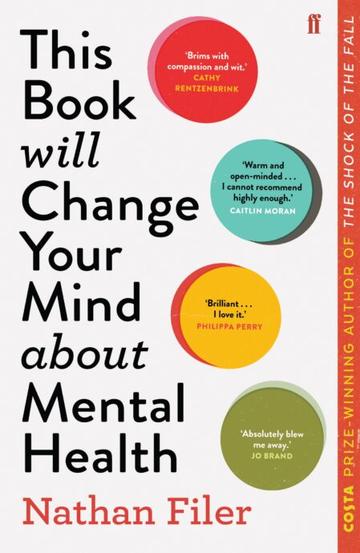This Book Will Change Your Mind About Mental Health by Nathan Filer
This Book Will Change Your Mind About Mental Health by Nathan Filer

The basic premise of this book is that schizophrenia is the heartland of mental illness, and offers an excellent case study into the biopsychosocial factors influencing both mental health, and various populations’ responses to mental ill health in others. Filer therefore takes a specific disorder, and uses it to deconstruct ideas of disorder, diagnosis, treatment, drugs, and other contextual elements. On the back cover we’re told it “debunks myths, challenges assumptions and offers fresh insights into what it means to be mentally ill. And what it means to be human.” Grand, provocative statements, and I’d expect nothing less from a book with such a grand and ambiguous title (is changing my mind about opinion, or is my mental health and my perception of it also at stake in the change brought about by this book?). I’m not sure, however, that it delivers on its promise, and to that extent, the hyperbole on the cover (e.g. “I have never read a more powerful book about mental health”) needs, I think, interrogating and challenging through the lens of how Filer discusses mental health.
Filer opens the book with a discussion about language around mental health. The book is based around a sequence of individual stories, trying to help us understand mental illness from the inside out. Aware that terms such as “mental illness”, and “schizophrenia” are very baggage-laden and contested, however, Filer makes the deliberate choice, talked out in the chapter, to say “so-called” in front of these terms unless they’re how others have chosen to use them, so as not to lay his own cards on the table, leaving space for differences in opinion about the terms. This fence-sitting is itself ideologically laden and somewhat disingenuous, as it leaves the problems of labels largely laid aside. Not wholly laid aside, as discussions about the subjective nature of diagnosis and changing DSM criteria demonstrate, but without space for real thought.[1] Instead, I found myself checking every time one of those terms came up whether the “so-called” tag was there, and if not, why not, along with wondering why only those two terms? Disruption to the reading experience through this terminological conceit may have been his objective, as it did force me to stop and think, but I’m not sure my thinking was the kind needed.
We meet a fashion writer and journalist, a soldier, a mental health practitioner, a mother, a son, and others not so defined by their roles. The cases he cites are all extreme, and herein lies one challenge in reading the book. Another dustjacket quote, “Brims with compassion and wit”, is pertinent here. There’s a levity to the writing which shows up in the sarcastic, self-referential footnotes, the fragmented writing, the personal commentary. It is in stark contrast to the seriousness of the life experiences he describes, which is part of the point. In the unease created by the clash, we are required to challenge what we think about mental illness, and how we talk about it. But the extremes remain, and to that extent, the amazing people who are profiled remain distant and unrelatable to, despite the compassionate telling of their stories. Another review (Paul Broks, for Literary Review) experiences the opposite, writing “Filer makes these troubled people reachable, fathomable…”. In this quotation, however, I see an exacerbation of the same issue. People with schizophrenia are “othered” as “these people” in order to need to be “made fathomable”. Most of us will never experience what could be classified as schizophrenia, even if, as Filer demonstrates, most of us do experience what might be classified as psychosis or hallucinations. He wants to show that there is a spectrum, and in discussing diagnostic criteria, the idea that schizophrenia is an extreme / extended / repeated form of psychosis, and therefore an extension of normal human experience is compelling, but not always convincing.
He does give us a short but useful history of the DSM, its equivalents worldwide, and a discussion of its uses and limitations. Diagnosis is a central theme running through the book, as he demonstrates the similarities and the differences between his contributors, and tries to unite what is common, while giving each space to be themselves in their own contexts; as one participant describes it, he has “James syndrome”, that is, he gets mentally unwell in a way that is predictable and characteristic for him, which exhibits traits of many DSM disorders, and may be diagnosable as schizophrenia, but this diagnosis does not help him get or stay well, and is therefore of no use to him, whereas e.g. his partner’s support is. This asks the question of what, or who, diagnosis is for, and to which one answer is treatment.
Treatment brings up the thorny issue of medication, and Filer does a good job of exploring pros and cons of psychiatric medication. In offering such an exploration and balance, he may risk becoming a poster boy for a movement which avows all psychiatric medication, when for many (as Filer does point out), it can be a lifesaver. It’s not an easy topic, and really needs clear signposting to where to find out more, because what’s at stake in holding firm views either way can be so significant.
Discussing treatment also returns us to the idea of what we are treating and why. Herein lies another concern I have with the book. Filer classifies neurodivergence as mental illness, linking ADHD and autism (largely agreed to be mainly developmental rather than acquired disorders) with psychiatric disorders. This theme continues as he discusses the genetics of psychosis, and the expression of various genetic faults as both positive and negative personality features, with both mental illness and neurodivergent traits as consequences. This feels like a category error. It may not be one of his own making, given his reliance on DSM criteria, but it is one which he does not challenge, unlike various other issues. To frame neurodivergence in the context of mental illness, without further discussion, seems to me irresponsible and short-sighted. There’s a lot which could have been said here, but again, sometimes he lifts the lid, or indeed here points to the lid, without really giving space to the problems raised.
He does return regularly to discussions about dopamine, whose role in ADHD experiences is widely recognised, if not fully understood. This, linked to a nuanced and sensitive series of discussions about things such as the threat-suspicion systems, raises huge questions which would have benefitted from greater attention. He elegantly demonstrates how hallucinations can be the natural products of brains whose cognitive functions have overtaken their sensory input analysis, and for a neurodivergent audience used to sensory overwhelm or shutdown, and either heightened emotions or alexithymia, this way of framing the relationship between different ways of constructing perception and understanding could be extremely useful.
Changing minds about mental health is a worthy and important aim, but we also need to focus on the practical impact of attitudinal change, including lobbying against the reduction in budgets for mental health. Filer notes a shift in treatment from “let’s see how this goes before bringing in medication” to “early intervention in psychosis is crucial”. He attributes this in part to the reduction in services, and the more critical state patients (or clients, or service users) find themselves in before they receive psychiatric support. The tangible consequences of a lack of systematic funding support in both treatment and research are clear, but in remaining relatively neutral about any particular government or policy (again with a slight sense of disingenuous faux-objectivity), he does demonstrate the relationship between health and politics.
One topic I think is handled particularly awkwardly is religion. Religion makes an appearance at various points throughout the book, but not generally in a positive or focussed way. In fact, the sense of religious experience as delusional in a negative sense comes through strongly, almost mocking the people whose collective religious experience is described. This makes the book an alienating read for anyone with a faith; for too long have mental health services characterised strong faith as a crutch, or a symptom of illness. There has been progress, but that progress is absolutely not supported by this book. One book can’t tackle every problematic angle of mental health, that’s true, but to weave in a religious narrative without acknowledgement that it could be anything other than problematic is unhelpful.
This religious focus links strongly with his discussion of community. His focus on community and the role it plays in managing mental health is important. He raises questions of causation and correlation, of context and shared experience, in both the development and management of mental illness. He reminds us how much bias there is about certain kinds of illness, and towards certain groups of people. He challenges the very concept of stigma, defining it as referring to someone’s feelings of shame, disgrace, or inadequacy due to their circumstances. He deconstructs this as individualising results of discrimination, rather than addressing the cause of the prejudice and discrimination which precipitate those feelings, in an individual or a culture at large.
Filer tells us that this book has been a journey for him, as well as us. That’s not an unusual trope, but given his insider status, and the fence-sitting on many key topics, this apparent reflective practice feels like a false humility – we learn very little about how his changed mind on mental health has manifested itself in his practice since his days of restraining people for forced medication. His conclusion provides a clear summary of his main points, but feels unbalanced, as though the book has prioritised certain aspects of the story, but others are where he wants to lead us.
The book is worth reading, but in celebrating diversity and trying to talk about schizophrenia in ways which do not scare a reader, I find myself wondering whose mind he was setting out to change, and whether the people who really need to read this book are the ones who will ever pick it up. Given the platform for this review, I am also concerned that neurodivergent readers may not find it accessible or supportive; I would caution neurodivergent readers to consider how they might respond to the presentation of neurodivergence he offers before reading this book.
[1] This is the Diagnostic and Statistical Manual of Mental Disorders (DSM-5-TR), currently in its fifth edition: https://www.psychiatry.org/dsm5.

Cressida Ryan is Lecturer in New Testament Greek in the Faculty of Theology and Religion. She researches the reception of Sophocles in the Early Modern period, Neo-Latin drama, and language pedagogy from 1500 to the present day. This includes both how the Martin Luther learned Greek influenced the development of the Reformation, and how we can design more inclusive language pedagogy for today.



